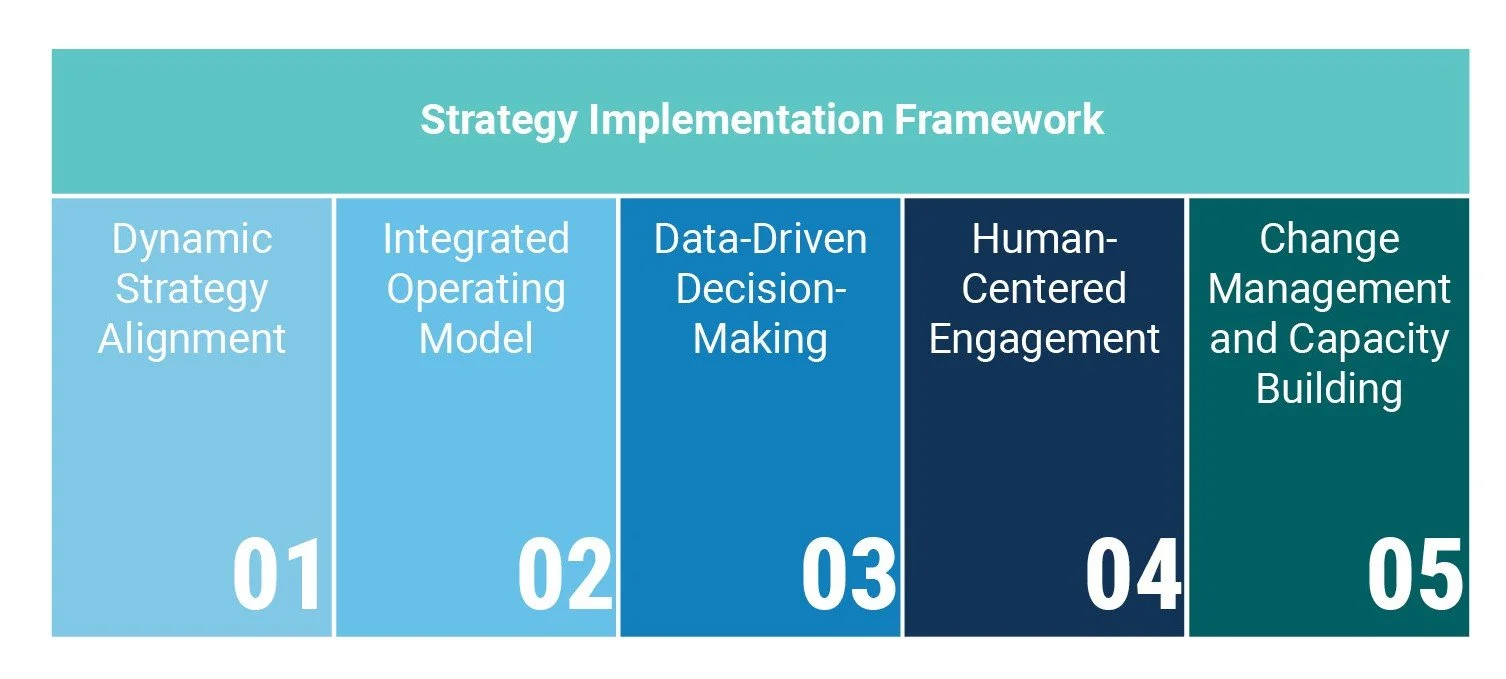Strategy Implementation in the GCC
Strategy Implementation in the GCC: Bridging Vision and Reality
The approval of a strategy is often celebrated as a milestone toward realizing a defined vision. However, the true journey begins with implementation, the incremental and cumulatively transformative efforts that bridge aspiration and achievement. This process hinges on the engagement, adoption, and sustained support of diverse stakeholders over time, even amidst uncontrollable circumstances. Strategy implementation not only tests the viability of the original strategy but also challenges teams to navigate complexities while maintaining fidelity to the overarching vision.
In the GCC, this challenge has taken on heightened significance with transformative initiatives such as Saudi Arabia’s Vision 2030, which has redefined development at an unprecedented pace and scale. Similar programs in the UAE, Qatar, and Oman are driving rapid change as governments and organizations strive to achieve ambitious objectives. These strategies seek to diversify economies, modernize governance, and foster innovation, reflecting a bold commitment to systemic transformation.
Strategy implementation, in this context, is not just important, it is mission-critical. It is the bridge that ensures ambitious visions translate into tangible, sustainable results. To succeed, organizations need more than a well-crafted roadmap. They require partners who can navigate the intricate realities of execution, adapt to changing conditions, align stakeholders, establish operational readiness, and drive measurable impact, all within the fast-moving and high-pressure environment of the GCC.
The Realities of Strategy Implementation
The journey from vision to execution presents both opportunities and complexities, shaped by the unique context of the GCC region. Strategy implementation offers a significant chance to address gaps between aspirations and outcomes, identifying areas for growth and alignment to achieve sustainable success.
The Pace of Change
The pace of transformation in the GCC is unparalleled. Strategies often evolve in tandem with the implementation of subsequent initiatives, creating opportunities for innovation but also the need for careful coordination. The region's rapid development can outpace traditional implementation models, requiring constant adaptation to shifting market conditions, technological advancements, and geopolitical factors.
Aligning and Integrating Strategies
The complexity of sectoral, regional, and national initiatives in the GCC provides opportunities for synergy but also requires careful alignment. Bridging gaps between sectoral plans and overarching national visions is essential to avoid duplication of efforts and conflicting priorities.
Governance and Decision-Making
Governance and decision-making frameworks are essential for effective strategy implementation, given the involvement of multiple stakeholders across public, private, and international domains. Clear governance structures streamline decision-making, define roles and responsibilities, and enhance accountability, reducing delays and inefficiencies.
Delivering Results with Long-Term Impact
The high stakes underscore the importance of achieving results efficiently and effectively. While urgency can drive momentum, it is vital to balance quick wins with long-term system readiness. A culture that prioritizes root-cause problem-solving and strengthens internal ownership ensures that outcomes are not only immediate but also sustainable.
Capacity Building for Long-Term Ownership
Clients’ human resources play a critical role in executing strategies, yet they sometimes face capacity limitations. While external consultants provide valuable expertise, empowering internal teams for long-term ownership ensures sustainable success. Addressing turnover and continuity challenges by investing in training, leadership development, and knowledge transfer can strengthen institutional memory and foster resilience.
A Strategy Implementation Framework
Effective strategy implementation requires a comprehensive framework that integrates the technical, human, and contextual dimensions of execution. The requirements outlined above reveal that success lies in balancing ambition with practicality, urgency with sustainability, and independence with collaboration. Based on insights from projects Beyond Group is working on in GCC countries, a framework for strategy implementation is designed around five interconnected pillars:
Pillar 1: Dynamic Strategy Alignment
Implementation begins with ensuring alignment between overarching goals, sectoral initiatives, and on-the-ground realities. This involves creating coordination mechanisms to manage overlaps and mitigate fragmentation, ensuring that all efforts contribute cohesively to the broader vision. Flexibility must be built into this alignment process to adapt to rapid changes in market dynamics, technologies, and geopolitical factors.
Pillar 2: Integrated Operating Model
A strong operating model must balance oversight and agility. This involves three levels of governance: maintaining strategic focus, ensuring initiative alignment, and tracking performance through reliable data systems. The operating model should also incorporate mechanisms for stakeholder engagement to align diverse interests and sustain collaboration across sectors.
Pillar 3: Data-Driven Decision-Making
Reliable data and strong governance frameworks are essential for tracking progress, identifying risks, and making informed decisions. Real-time data analytics can offer actionable insights to refine implementation processes and sustain momentum, ensuring that strategies remain relevant and impactful as conditions evolve.
Pillar 4: Human-Centered Engagement
Addressing the cultural, behavioral, and contextual challenges of implementation is critical. This pillar emphasizes the importance of empathy, active listening, and cultural sensitivity to build trust and encourage stakeholder buy-in. A human-centered approach not only aligns people with the strategy but also enhances the adaptability and relevance of solutions in dynamic environments.
Pillar 5: Change Management and Capacity Building
Sustainable implementation hinges on effective change management paired with capacity building programs. Empowering internal teams through targeted investments in training, leadership development, and knowledge transfer ensures they are equipped to adapt to change and drive the strategy forward. By fostering a sense of ownership over both the strategy and its execution, organizations build resilience and accountability, creating the foundation for long-term success
At its core, effective implementation involves asking the right questions to bridge the gap between aspirations and outcomes: How can a culture of accountability be fostered in public sector institutions? What strategies can align diverse stakeholders around a shared vision? How can stakeholder adoption of a strategy be sustained in a rapidly evolving environment? A human-centered approach is essential, one that tackles cultural dynamics, behaviors, and stakeholder alignment to ensure success.


